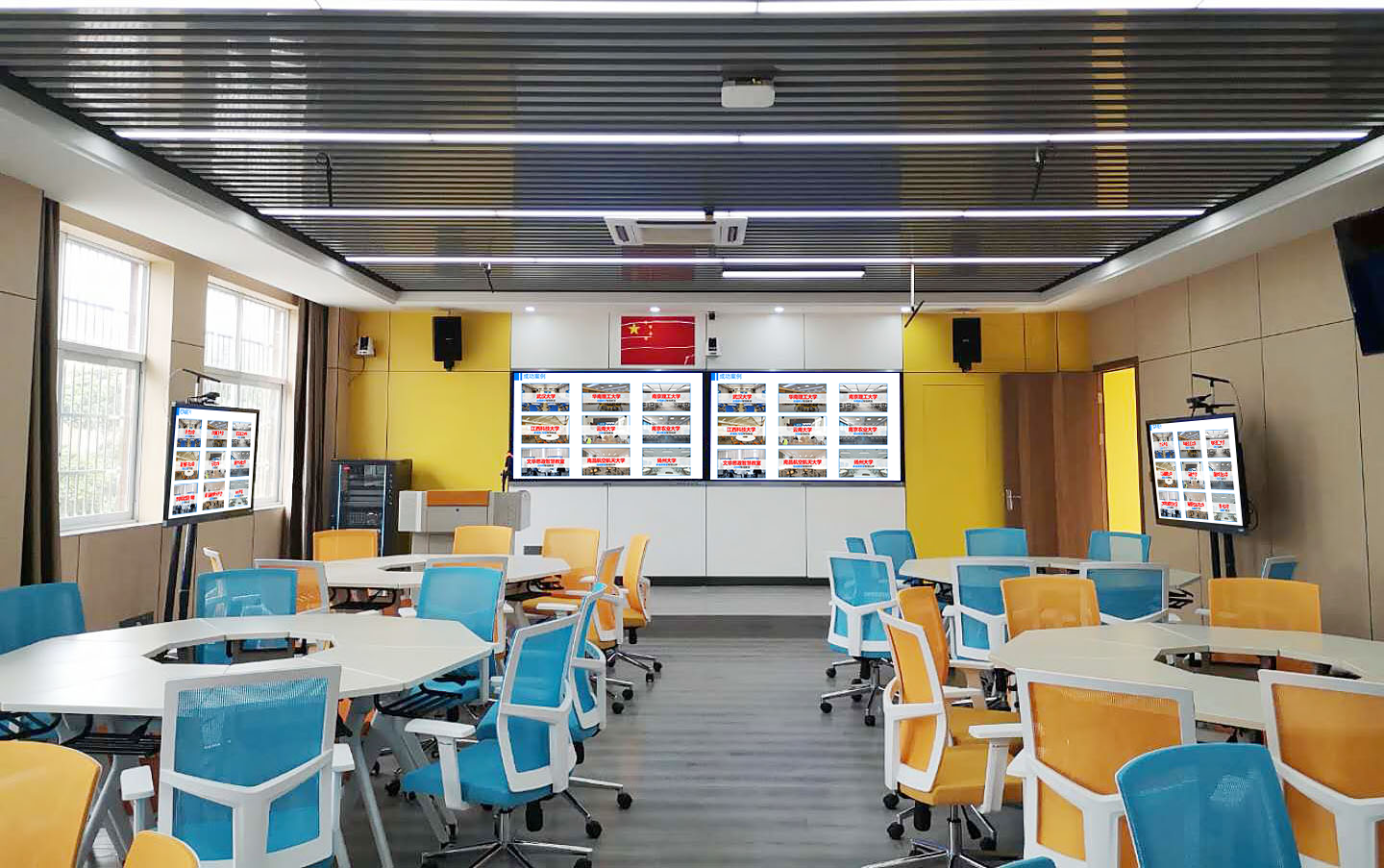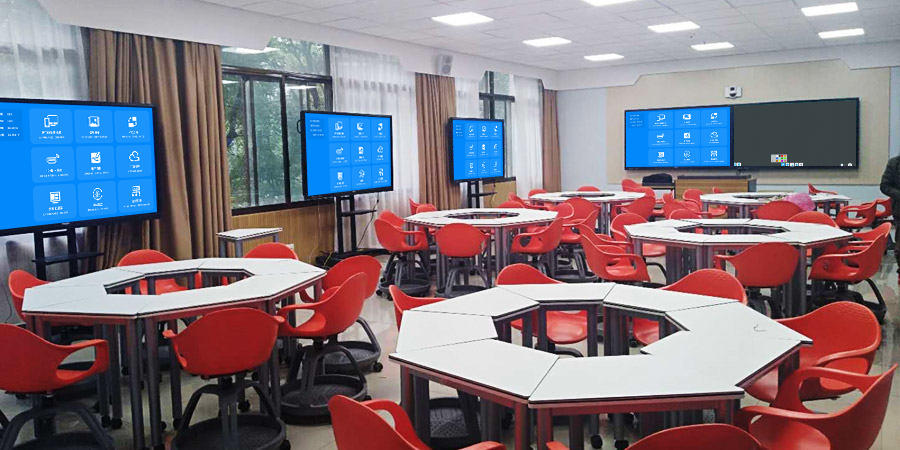Use This for Group Discussions: More Efficient Collaboration and Communication
Want to solve the problem of “difficult to sync results and low sharing efficiency” during group discussions? This screen mirroring device makes high-efficiency collaboration easy! It supports multi-device linkage, split-screen display, and real-time annotation, adapting to scenarios like corporate meetings, classroom teaching, and training workshops. It transforms group discussions from “dispersed conversation” to “aggregated communication,” ensuring results are implemented more efficiently.
3 Steps to a Discussion Setup: Zero-Barrier for Group Collaboration
No complex debugging is needed. Quickly enable multi-group linkage with simple operations:
- Quick Hardware Connection: Plug the receiver into the public main screen and each group’s sub-screen. Plug the transmitter into the core device of each group (computer / tablet). Group members then scan a QR code to join their respective group, completing the device network in 10 seconds without having to repeatedly match networks.
- Configure Group Permissions: An administrator can tap a button on the device’s backend to divide groups (e.g., “Group 1 – Marketing Dept,” “Group 2 – Tech Dept”). It automatically assigns “Intra-group Permissions” (members can share materials with each other) and “Public Permissions” (only the group leader can push results to the main screen) to prevent chaos.
- Start Discussion Mode: Click the “Discussion” button on the device. The public main screen, the group sub-screens, and all devices instantly connect. Intra-group collaboration and cross-group sharing are enabled simultaneously. The entire process takes less than a minute, so even new users can get started quickly.
Core Advantages: More Flexible and In-Depth Group Discussions
Intra-Group Collaboration: Unobstructed Material Flow
- High-Efficiency Multi-Device Transfer: Group members can take notes on their phones, draw mind maps on their tablets, and organize data on their computers. The “intra-group push” function allows materials to be instantly transferred, eliminating the need for WeChat or USB drives and boosting material collection efficiency by 70%. For example, during a design group discussion, a designer can send a design draft from their computer, while a copywriter adds text on their tablet. The content is synchronized in real-time to the group’s sub-screen, ensuring a seamless workflow.
- Collaborative Real-time Annotation: Revision suggestions (circling key points, adding data) annotated by group members on the mirrored content are synchronized in real-time to all devices in the group. There’s no need to “pass the screen around,” making discussions more focused. The group leader can lock key annotations with one click to prevent them from being missed later.
- Sub-Screen Synchronization for Focus: The group can project its core ideas onto a dedicated sub-screen. When members gather around to discuss, they don’t have to crowd around a small screen. Details are clearly visible, and the division of labor is smoother (e.g., one person explains while another adds revisions, with the content synchronized in real-time).
Results Presentation: More Efficient Cross-Group Synchronization
- Parallel Split-Screen Display: After completing their discussion, groups can simultaneously push their results to the public main screen. The screen supports displaying content from 2-4 groups at once (e.g., the left side of the main screen shows Group 1’s plan, the right side shows Group 2’s). This allows for direct and clear cross-group comparison, avoiding the issue of “time-consuming sequential mirroring.” For example, in a corporate discussion, the marketing group can project user research while the tech group projects the implementation path, with dual-screen linkage leading to faster decision-making.
- One-Click Focus: When a specific group’s results need a more detailed explanation, an administrator can tap “Display Separately,” and the main screen will automatically focus on that group’s content while temporarily hiding others. After the explanation, a single click restores the split-screen display, allowing for flexible control of the discussion pace.
- QR Code for Saving Results: When each group presents its results, other members can scan a QR code on the main screen to save all the groups’ documents. This makes it convenient and efficient for post-meeting review, with no need to request materials one by one.
Global Interaction: More Thorough Cross-Group Communication
- Public Annotation for Suggestions: When a group presents its results, other groups can add suggestions in the “Public Annotation Area” via their phones/tablets (e.g., “You could add a case study here” or “Suggest optimizing the process”). The annotations are displayed in real-time on the main screen, making cross-group communication more direct.
- Voting to Decide Direction: After all groups have presented, an administrator can project “Voting Options” to the main screen. Members can scan a QR code to vote (e.g., “Best Proposal Vote,” “Points to Optimize Vote”). The results are displayed in 3 seconds, quickly aligning the discussion’s direction.
- Seamless Remote Group Integration: If a group member is participating remotely, they can connect to the device via their phone/computer to join the discussion and view results in real-time. This ensures a seamless workflow between remote and in-person teams. For example, a team from a different branch office can participate in a headquarters discussion with high-efficiency interaction.

All-Scenario Application: Adapting to Diverse Discussion Needs
Corporate Meetings: Boosting Decision-Making Efficiency
- During project proposal discussions, each department can outline their needs and develop a plan. They can present their work side-by-side using split-screen mirroring, allowing for a cross-departmental comparison of each plan’s strengths (e.g., the operations group projects an execution plan, the finance group projects a budget analysis), quickly identifying the optimal direction.
- During problem-solving discussions, each group can project a problem analysis report and improvement suggestions. The public annotation area aggregates cross-group feedback to form a unified solution, avoiding “repetitive, low-efficiency discussions.”
Educational Discussions: Deeper Interaction
- In-class group discussions for a project: Each group projects its research results and PPT to the main screen on a split-screen. Students can use the public annotation area to comment on each other’s work, and the teacher can provide targeted guidance, boosting classroom participation by 50%.
- In teaching and research activities: Each teacher group can project its lesson plans and courseware designs. They can then share teaching methods across groups (e.g., “You can add an interactive game here,” “I suggest using a short video to help explain”), working together to optimize teaching strategies.
Training Workshops: More Efficient Results Conversion
- During group discussions in corporate training, each group of trainees can project their case study analysis and practice plans. The instructor can use the public annotation area to add professional feedback, and other groups can learn from the best ideas, leading to faster conversion of training results.
- In industry exchange discussions, different company representatives can project their experience-sharing content, with a split-screen display for comparing industry practices. This encourages more thorough cross-company communication and broadens collaboration ideas.
Secure and Stable: Confidence in Use
- Permission Control for No Interference: An administrator can set permissions like “only allow intra-group transfers, prohibit mirroring to the main screen” and “public annotations must be approved before being displayed” to prevent irrelevant content from disrupting the discussion and ensure order.
- Stable Transmission with No Lag: Using dual-band transmission technology (2.4GHz + 5.8GHz), the latency is ≤20ms even when multiple groups are mirroring simultaneously. Documents, images, and videos display smoothly, with a disconnection rate of less than 0.1%, ensuring no interruptions during crucial discussions.
- Portable and Durable: The receiver is palm-sized and weighs less than 50g, making it easy to slip into a bag for off-site discussions or training. The casing is made of wear-resistant and anti-drop material, so it won’t be easily damaged by repeated plugging and unplugging, reducing maintenance costs.
- Encrypted Data for Security: Intra-group material transfers and result documents are fully encrypted. Only authorized devices can view them, so business secrets and teaching materials remain secure.
Whether for corporate meetings, classroom teaching, or training workshops, using this screen mirroring device for group discussions makes collaboration more efficient and communication more thorough. It easily achieves the goal of “dispersed discussion, efficient aggregation,” helping to quickly implement discussion results.